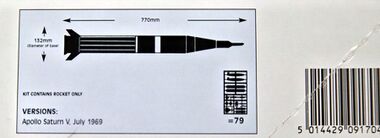Apollo Saturn V rocket (Airfix 09170)
| in storage |
|---|
Apollo Saturn V rocket (Airfix 09170) 2000 box, with coloured "difficulty" panel bottom-right (i) 2000 box, with coloured "difficulty" panel bottom-right (i)
|
|
|
| location: |
|
in storage 1970 |
Box end [image info]
Box detail [image info]
Instructions sheet, front page [image info]
An assembled and painted 1:144-scale model NASA Apollo Saturn V rocket, built from Airfix kit number 09170 (barcoded 091704).
The kit
Molded in white plastic, the kit has 79 parts, and builds to a model 770mm high and 132mm wide. The finished model can either be displayed as a simple unit, or in its various sections.
Period
Sometimes kits get revised to add features, sometimes they are changed to correct deficiencies, sometimes a mould needs to be modified to reflect the name of a new company, and sometimes a mould for a part simply wears out, and needs changing. According to the Scalemates site, this would appear to be a y2k reboxing of a kit that was originally made available in 1970, and had some parts revised or reworked in 1981. So the kit is technically from 1970/1981, but the box is from 2000.
Airfix overview text:
AIRFIX 1/144 SCALE MODEL CONSTRUCTION KIT 9170
APOLLO-SATURN V
The giant Saturn V is 363 feet high to the top of the launch escape tower and weighs over 3,800 tons.
It consists of eight basic units, the lowest of which is the 138 feet tall first stage, followed by the second stage, third stage, instrument unit, the lunar module in its housing, the service module, the command module and the launch escape system.
The first stage is powered by a cluster of five rocket engines which together produce 7 1/2 million pounds of thrust and burn 15 tons of kerosene and liquid oxygen per second to lift Saturn V over 35 miles into the sky.
When the first stage is discarded the five second stage rockets take over and deliver another 1,125,000 pounds thrust, increasing the height to over 100 miles and the speed to 15,300 m.p.h.
When the second stage breaks away the single 225,000 lb. thrust third stage engine fires for 2 1/2 minutes to boost the speed to 17,500 m.p.h. and place the vehicle in orbit around the earth.
The third stage rocket is re-ignited after one orbit and speed increases to 25,000 m.p.h. as Apollo reaches escape velocity and heads for the Moon.
On route to the Moon the lunar module housing is opened and the command and service modules are rotated to dock with the lunar module before the empty third stage is released.
The command and service modules with the lunar module attached enter into a Moon orbit after which two of the three astronauts crawl into the lunar module and after checks are completed the lunar module flies down to its controlled landing on the Moon.
Leaving the Moon, the ascent stage separates from the lower descent stage and rejoins the orbiting command module.
When the astronauts have once more entered the command module the lunar module is jettisoned and the two and a half day return voyage begins.
Before entering the earth's atmosphere the service module is discarded and the 5 ton command capsule, the actual spacecraft, becomes the only part to return to Earth.
After the atmosphere has slowed the command module its braking parachutes bring it to a gentle splashdown in the Pacific to await recovery by the ships and helicopters of the U.S. Navy.
Saturn V is the product of a concerted effort by the whole of the American aerospace industry. Boeing produce the first stage, North American Rockwell the second stage and McDonnell the third. The immensely powerful rocket motors are built by Rocketdyne and Grumman produce the lunar module.
— , Airfix,
External links






